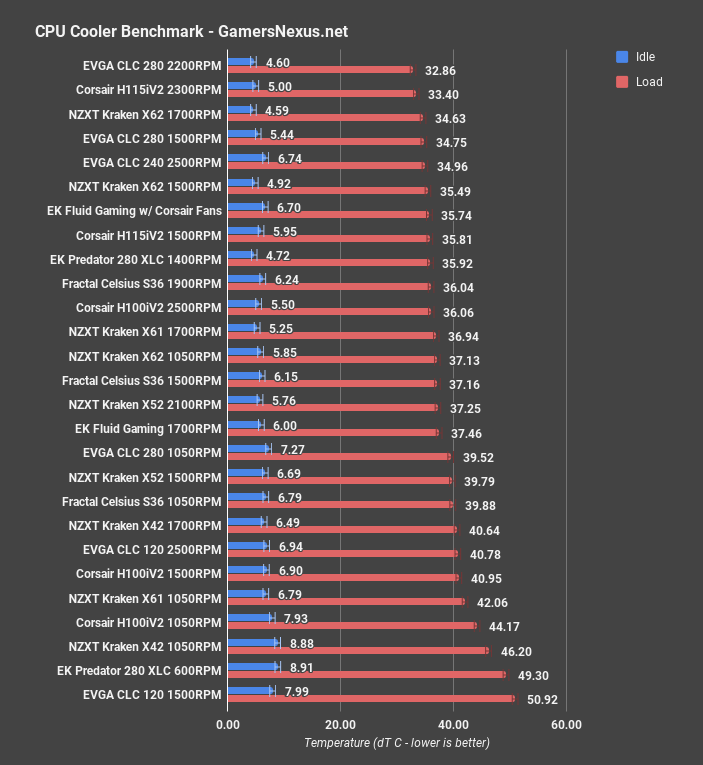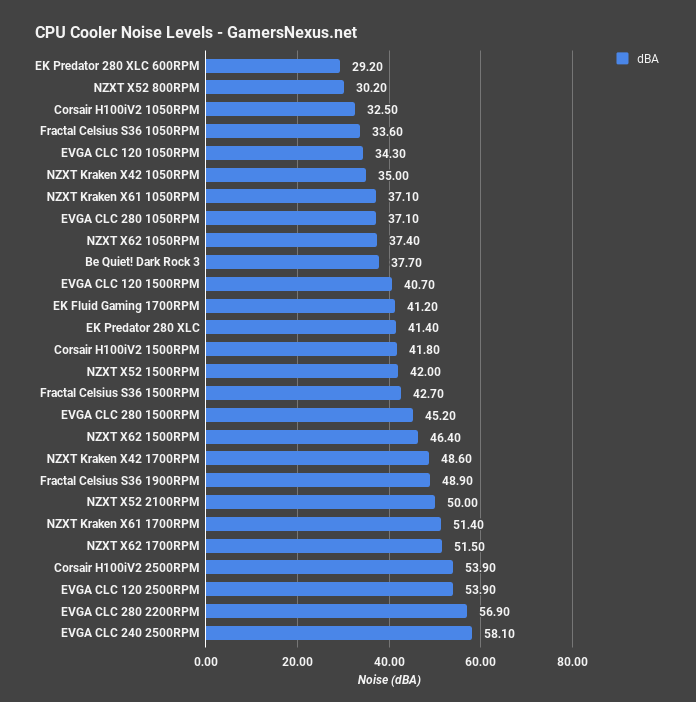There aren’t many ways for cooling manufacturers to differentiate atop of a supplier’s product, like the Asetek Gen5 pumps, but you’d be surprised at how much goes into them behind the scenes. NZXT was the first manufacturer permitted to build a fully custom and complex PCB for its RGB-illuminated Kraken coolers, followed-up in short order by EVGA, who dropped the price significantly for the same-size radiators. We’re reviewing the new EVGA CLC 240 today, following-up our previous (positive) CLC 280 and (negative) CLC 120 reviews.
Although they’re all ultimately Asetek products, the EVGA CLC series has thus far competed well with the NZXT Kraken and Corsair H-series coolers. EVGA aimed to strike a balance between the higher-cost features of the Kraken coolers (like manufacturer-customized lighting) and the more function-focused Corsair H-series coolers. The effort yielded ~$130 280mm closed-loop liquid coolers, coming in below the $150-$160 Kraken X52/X62 units and around the H115i (presently $140).
We generally liked the price:performance positioning of the CLC 280 unit, but found the CLC 120 nearly impossible to justify. The 120 wasn’t a far step from good 240mm coolers, like the H100i V2, but EVGA only recently began shipping CLC 240 units.
CPU Cooler Testing Methodology
CPU cooler testing is conducted using the bench defined below. We use a bench that is more carefully crafted for noise performance, opting for a passively cooled PSU and 23% RPM 980 Ti blower fan for very low system noise.
We strongly believe that our thermal testing methodology is among the best on this side of the tech-media industry. We've validated our testing methodology with thermal chambers and have proven near-perfect accuracy of results.
Conducting thermal tests requires careful measurement of temperatures in the surrounding environment. We control for ambient by constantly measuring temperatures with K-Type thermocouples and infrared readers. Two K-Type thermocouples are deployed around the test bench: One (T1) above the bench, out of airflow channels, and one (T2) approximately 2-3" in front of the cooler's intake fan. These two data points are averaged in a spreadsheet, creating a T3 value that is subtracted second-to-second from our AIDA64 logging of the CPU cores.
All six CPU cores are totaled and averaged second-to-second. The delta value is created by subtracting corresponding ambient readings (T3) from the average CPU core temperature. We then produce charts using a Delta T(emperature) over Ambient value. AIDA64 is used for logging thermals of silicon components, including the CPU and GPU diodes. We additionally log core utilization and frequencies to ensure all components are firing as expected. Voltage levels are measured in addition to fan speeds, frequencies, and thermals.
The cores are kept locked to 3.8GHz (x38 multiplier). VCore voltage is locked to 1.141v for the CPU. C-States are disabled, as is all other power saving. The frequency is locked without any interference from boost or throttle functions. This is to ensure that the CPU does not undergo any unexpected/uncontrollable power saving or boost states during testing, and ensures that the test platform remains identical from one device to the next.
Fan speeds are manually controlled unless otherwise defined. For liquid coolers, pumps are set to 100% speed unless otherwise defined.
No open bench fans are used for these CPU cooler tests. Only fans which are provided with the cooler are used.
| GN Test Bench 2015 | Name | Courtesy Of | Cost |
| Video Card | GTX 980 Ti Reference 23% RPM | NVIDIA | EOL |
| CPU | Intel i7-5930K CPU @ 3.8GHz | iBUYPOWER | $580 |
| Memory | Corsair Vengeance 32GB 2666MHz | Corsair | $175 |
| Motherboard | EVGA X99 Classified | GamersNexus | $365 |
| Power Supply | Enermax DigiFANLESS | Enermax | $250 |
| SSD | HyperX Savage SSD | Kingston Tech. | $130 |
| Case | Top Deck Tech Station | GamersNexus | $250 |
| CPU Cooler | This is what we're testing! | - | - |
We use an AMPROBE multi-diode thermocouple reader to log ambient actively. This ambient measurement is used to monitor fluctuations and is subtracted from absolute GPU diode readings to produce a delta value. For these tests, we configured the thermocouple reader's logging interval to 1s, matching the logging interval of GPU-Z and AIDA64. Data is calculated using a custom, in-house spreadsheet and software solution.
Our test starts with a 180s idle period to gauge non-gaming performance. A script automatically triggers the beginning of a CPU-intensive benchmark running Prime95 LFFTs. Because we use an in-house script, we are able to perfectly execute and align our tests between passes.
Thermal Torture – EVGA CLC 240 vs. Corsair H100i V2 & X52
Running our thermal torture test, EVGA’s CLC 240 cooler performs exceptionally well, landing at around cooling levels of the slowed-down RPM X62 or CLC 280. The advantage, of course, still goes to the larger coolers: By operating at 1500RPM, the X62 can match maxed-out CLC 240 performance, but at significantly lower noise levels. We’ll look at that in a moment. The same is true for the CLC 280, which roughly matches CLC 240 performance, but with lower RPM. At 34.96C over ambient, the CLC 240 places marginally cooler than the EK Fluid Gaming with Corsair’s H100iV2 fans.
Compared to the max RPM H100iV2 at 2500RPM, the CLC 240 manages about a 1C advantage, though is awfully close to our tolerances for error, considering a +/- 0.5C swing would equalize them.
EVGA CLC 240 Noise Levels
Strictly in terms of noise at peak RPM, which is what most of the previous chart’s numbers were based off of, EVGA manages to lay claim to the loudest cooler on the charts. At 58.1dBA, the CLC 240 is rivaling 100% RPM noise levels out of blower fans from reference GPU coolers. At this noise level, we’re in “intolerable” levels of whirring, but we obviously have full control to reduce that noise level. What we have now are numbers representing peak thermal performance and worst-case noise performance. For reference, the CLC 280 at 1500RPM matches 2500RPM CLC 240 performance, but operates at 45dBA versus 58dBA. This is more than a 2x perceived reduction in noise, as decibels are a logarithmic scale. The Kraken X62 at 1500RPM is in the same boat, achieving lower noise and equivalent performance. That’s the value of a bigger cooler.
Let’s move on to our newer noise-normalized thermal chart, where we configure all coolers to output a noise level of 40dBA and then thermally bench them.
EVGA CLC 240 Noise Normalized
Normalized at 40dBA on all coolers, +/- 0.5dBA, the 280mm and 360mm coolers predictably land at the top of the chart. This consists of the 280mm NZXT X62 at 1200RPM leading at 35C delta T over ambient, 360mm Celsius at 1350RPM at 37C over ambient, and 280mm H115i at 38C over ambient. We next hit the 40C mark with the EK Fluid Gaming 240 open loop kit, cooling only the CPU, and then encounter the CLC 240 at 1250RPM. The EK Fluid Gaming kit and EVGA CLC 240 are functionally equivalent in our noise-normalized cooling test, as 39.9C and 40.3C fall within usual variance of the test.
Corsair’s competing 240mm H100iV2 falls behind at 42C when noise-normalized, and is the closest thing to competition on this newer chart. The H100iV2 is the same price as the EVGA CLC 240, so EVGA does command a small victory, here, but a 2-degree difference isn’t much of one to phone home about. You can buy either cooler knowing that they perform reasonably at 40dBA, particularly given that they’re about the same price, but be aware
Conclusion
The EVGA CLC 240 further eliminates need for the CLC 120, lest some specific small form factor use case arises. The CLC 240 competes directly with Corsair’s H100i V2, both priced at $110 with $10 MIRs at time of this content (via Newegg). The primary ups and downs of these two pertain to visuals, which are entirely up to you (as the reader) to split. That’s largely the difference. Our EVGA unit tested at slightly better performance when noise normalized, but nothing that’d make or break an overclock.
Editorial: Steve Burke
Video: Andrew Coleman


